Arab vs Spaniard Community Comparison
COMPARE
Arab
Spaniard
Social Comparison
Social Comparison
Arabs
Spaniards
6,013
SOCIAL INDEX
57.6/ 100
SOCIAL RATING
166th/ 347
SOCIAL RANK
3,805
SOCIAL INDEX
35.6/ 100
SOCIAL RATING
210th/ 347
SOCIAL RANK
Spaniard Integration in Arab Communities
The statistical analysis conducted on geographies consisting of 409,367,443 people shows a mild negative correlation between the proportion of Spaniards within Arab communities in the United States with a correlation coefficient (R) of -0.341. On average, for every 1% (one percent) increase in Arabs within a typical geography, there is a decrease of 0.006% in Spaniards. To illustrate, in a geography comprising of 100,000 individuals, a rise of 1,000 Arabs corresponds to a decrease of 5.9 Spaniards.
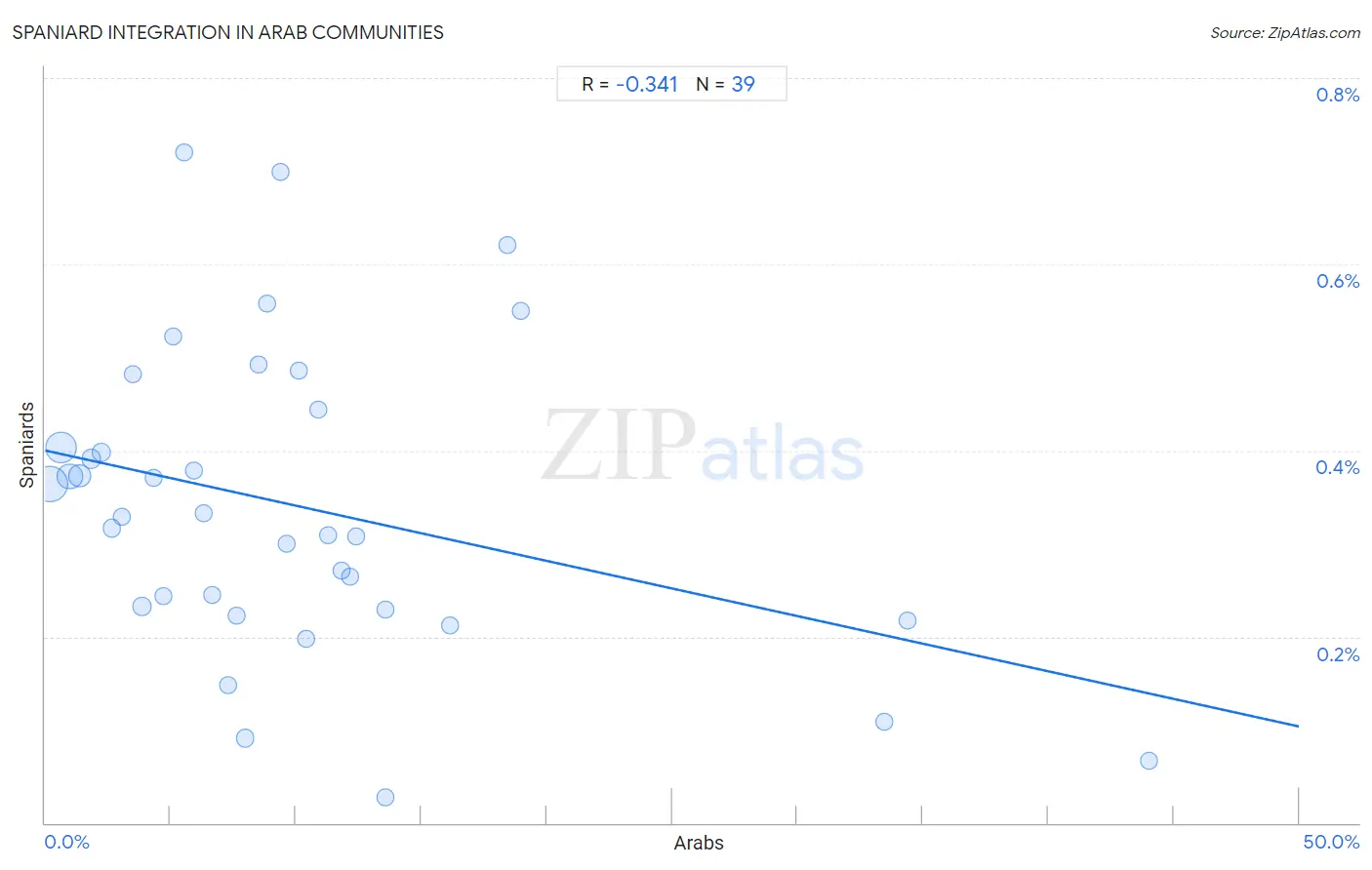
Arab vs Spaniard Income
When considering income, the most significant differences between Arab and Spaniard communities in the United States are seen in per capita income ($45,662 compared to $43,028, a difference of 6.1%), median earnings ($48,599 compared to $46,059, a difference of 5.5%), and median male earnings ($57,298 compared to $54,401, a difference of 5.3%). Conversely, both communities are more comparable in terms of householder income under 25 years ($51,219 compared to $51,117, a difference of 0.20%), wage/income gap (26.6% compared to 27.0%, a difference of 1.3%), and householder income over 65 years ($62,266 compared to $60,866, a difference of 2.3%).

| Income Metric | Arab | Spaniard |
| Per Capita Income | Exceptional $45,662 | Fair $43,028 |
| Median Family Income | Excellent $106,952 | Fair $101,617 |
| Median Household Income | Excellent $88,398 | Average $84,644 |
| Median Earnings | Exceptional $48,599 | Fair $46,059 |
| Median Male Earnings | Exceptional $57,298 | Average $54,401 |
| Median Female Earnings | Excellent $40,718 | Poor $38,656 |
| Householder Age | Under 25 years | Tragic $51,219 | Tragic $51,117 |
| Householder Age | 25 - 44 years | Excellent $97,336 | Fair $93,366 |
| Householder Age | 45 - 64 years | Excellent $104,566 | Average $99,889 |
| Householder Age | Over 65 years | Good $62,266 | Average $60,866 |
| Wage/Income Gap | Poor 26.6% | Tragic 27.0% |
Arab vs Spaniard Poverty
When considering poverty, the most significant differences between Arab and Spaniard communities in the United States are seen in female poverty among 25-34 year olds (13.2% compared to 14.6%, a difference of 10.1%), single female poverty (20.7% compared to 22.0%, a difference of 6.2%), and single male poverty (13.0% compared to 13.7%, a difference of 5.8%). Conversely, both communities are more comparable in terms of female poverty among 18-24 year olds (20.5% compared to 20.5%, a difference of 0.070%), seniors poverty over the age of 75 (12.2% compared to 12.2%, a difference of 0.090%), and male poverty (11.6% compared to 11.7%, a difference of 0.42%).
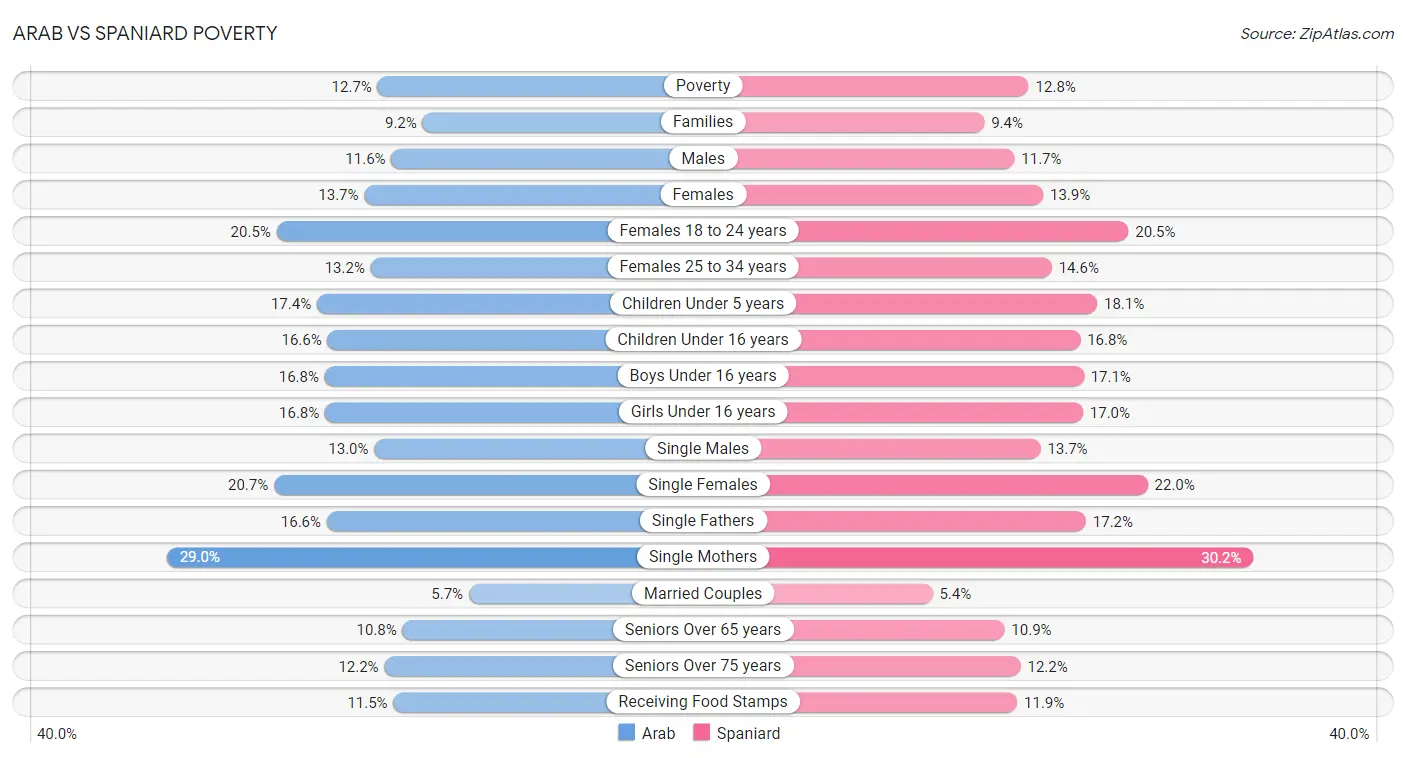
| Poverty Metric | Arab | Spaniard |
| Poverty | Fair 12.7% | Poor 12.8% |
| Families | Fair 9.2% | Fair 9.4% |
| Males | Poor 11.6% | Poor 11.7% |
| Females | Fair 13.7% | Poor 13.9% |
| Females 18 to 24 years | Poor 20.5% | Poor 20.5% |
| Females 25 to 34 years | Good 13.2% | Tragic 14.6% |
| Children Under 5 years | Average 17.4% | Poor 18.1% |
| Children Under 16 years | Fair 16.6% | Fair 16.8% |
| Boys Under 16 years | Fair 16.8% | Fair 17.1% |
| Girls Under 16 years | Fair 16.8% | Fair 17.0% |
| Single Males | Fair 13.0% | Tragic 13.7% |
| Single Females | Good 20.7% | Tragic 22.0% |
| Single Fathers | Poor 16.6% | Tragic 17.2% |
| Single Mothers | Good 29.0% | Tragic 30.2% |
| Married Couples | Tragic 5.7% | Fair 5.4% |
| Seniors Over 65 years | Good 10.8% | Average 10.9% |
| Seniors Over 75 years | Average 12.2% | Average 12.2% |
| Receiving Food Stamps | Good 11.5% | Fair 11.9% |
Arab vs Spaniard Unemployment
When considering unemployment, the most significant differences between Arab and Spaniard communities in the United States are seen in unemployment among seniors over 75 years (9.5% compared to 8.9%, a difference of 6.6%), unemployment among ages 30 to 34 years (5.4% compared to 5.8%, a difference of 6.5%), and unemployment among ages 25 to 29 years (6.5% compared to 6.9%, a difference of 6.4%). Conversely, both communities are more comparable in terms of unemployment among women with children under 18 years (5.6% compared to 5.6%, a difference of 0.14%), female unemployment (5.3% compared to 5.3%, a difference of 0.19%), and male unemployment (5.4% compared to 5.3%, a difference of 0.32%).
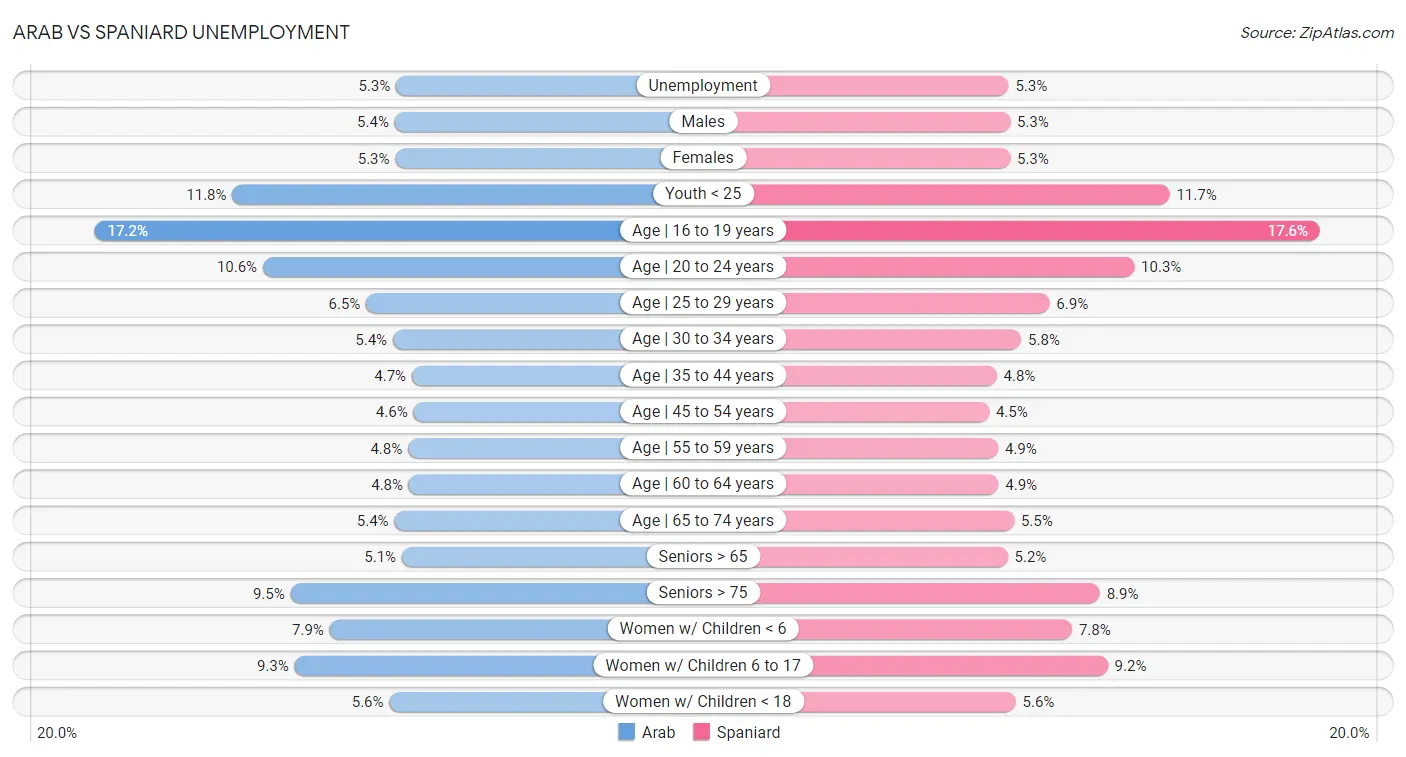
| Unemployment Metric | Arab | Spaniard |
| Unemployment | Fair 5.3% | Average 5.3% |
| Males | Fair 5.4% | Fair 5.3% |
| Females | Fair 5.3% | Fair 5.3% |
| Youth < 25 | Poor 11.8% | Fair 11.7% |
| Age | 16 to 19 years | Excellent 17.2% | Average 17.6% |
| Age | 20 to 24 years | Tragic 10.6% | Good 10.3% |
| Age | 25 to 29 years | Excellent 6.5% | Tragic 6.9% |
| Age | 30 to 34 years | Average 5.4% | Tragic 5.8% |
| Age | 35 to 44 years | Average 4.7% | Poor 4.8% |
| Age | 45 to 54 years | Poor 4.6% | Average 4.5% |
| Age | 55 to 59 years | Average 4.8% | Fair 4.9% |
| Age | 60 to 64 years | Good 4.8% | Fair 4.9% |
| Age | 65 to 74 years | Average 5.4% | Tragic 5.5% |
| Seniors > 65 | Excellent 5.1% | Tragic 5.2% |
| Seniors > 75 | Tragic 9.5% | Fair 8.9% |
| Women w/ Children < 6 | Tragic 7.9% | Fair 7.8% |
| Women w/ Children 6 to 17 | Tragic 9.3% | Tragic 9.2% |
| Women w/ Children < 18 | Fair 5.6% | Fair 5.6% |
Arab vs Spaniard Labor Participation
When considering labor participation, the most significant differences between Arab and Spaniard communities in the United States are seen in in labor force | age 16-19 (36.8% compared to 38.0%, a difference of 3.1%), in labor force | age > 16 (65.2% compared to 64.1%, a difference of 1.7%), and in labor force | age 20-24 (74.6% compared to 75.5%, a difference of 1.2%). Conversely, both communities are more comparable in terms of in labor force | age 35-44 (83.8% compared to 83.4%, a difference of 0.42%), in labor force | age 25-29 (84.2% compared to 83.7%, a difference of 0.67%), and in labor force | age 30-34 (84.3% compared to 83.6%, a difference of 0.87%).

| Labor Participation Metric | Arab | Spaniard |
| In Labor Force | Age > 16 | Good 65.2% | Tragic 64.1% |
| In Labor Force | Age 20-64 | Poor 79.2% | Tragic 78.4% |
| In Labor Force | Age 16-19 | Good 36.8% | Exceptional 38.0% |
| In Labor Force | Age 20-24 | Poor 74.6% | Excellent 75.5% |
| In Labor Force | Age 25-29 | Tragic 84.2% | Tragic 83.7% |
| In Labor Force | Age 30-34 | Tragic 84.3% | Tragic 83.6% |
| In Labor Force | Age 35-44 | Tragic 83.8% | Tragic 83.4% |
| In Labor Force | Age 45-54 | Poor 82.4% | Tragic 81.5% |
Arab vs Spaniard Family Structure
When considering family structure, the most significant differences between Arab and Spaniard communities in the United States are seen in single father households (2.1% compared to 2.5%, a difference of 16.6%), births to unmarried women (29.2% compared to 33.6%, a difference of 15.1%), and divorced or separated (11.6% compared to 12.7%, a difference of 9.5%). Conversely, both communities are more comparable in terms of family households with children (28.0% compared to 28.0%, a difference of 0.10%), average family size (3.23 compared to 3.23, a difference of 0.12%), and currently married (47.0% compared to 46.8%, a difference of 0.39%).

| Family Structure Metric | Arab | Spaniard |
| Family Households | Fair 64.1% | Exceptional 65.1% |
| Family Households with Children | Exceptional 28.0% | Exceptional 28.0% |
| Married-couple Households | Good 46.9% | Excellent 47.2% |
| Average Family Size | Average 3.23 | Average 3.23 |
| Single Father Households | Exceptional 2.1% | Tragic 2.5% |
| Single Mother Households | Excellent 6.0% | Fair 6.5% |
| Currently Married | Good 47.0% | Average 46.8% |
| Divorced or Separated | Exceptional 11.6% | Tragic 12.7% |
| Births to Unmarried Women | Exceptional 29.2% | Tragic 33.6% |
Arab vs Spaniard Vehicle Availability
When considering vehicle availability, the most significant differences between Arab and Spaniard communities in the United States are seen in 4 or more vehicles in household (6.0% compared to 7.6%, a difference of 26.0%), no vehicles in household (10.5% compared to 8.4%, a difference of 25.1%), and 3 or more vehicles in household (18.9% compared to 22.3%, a difference of 17.8%). Conversely, both communities are more comparable in terms of 1 or more vehicles in household (89.6% compared to 91.8%, a difference of 2.4%), 2 or more vehicles in household (55.0% compared to 59.2%, a difference of 7.5%), and 3 or more vehicles in household (18.9% compared to 22.3%, a difference of 17.8%).

| Vehicle Availability Metric | Arab | Spaniard |
| No Vehicles Available | Average 10.5% | Exceptional 8.4% |
| 1+ Vehicles Available | Average 89.6% | Exceptional 91.8% |
| 2+ Vehicles Available | Fair 55.0% | Exceptional 59.2% |
| 3+ Vehicles Available | Poor 18.9% | Exceptional 22.3% |
| 4+ Vehicles Available | Poor 6.0% | Exceptional 7.6% |
Arab vs Spaniard Education Level
When considering education level, the most significant differences between Arab and Spaniard communities in the United States are seen in professional degree (5.0% compared to 4.4%, a difference of 14.2%), master's degree (16.7% compared to 14.6%, a difference of 14.1%), and bachelor's degree (40.9% compared to 36.6%, a difference of 11.7%). Conversely, both communities are more comparable in terms of 7th grade (96.2% compared to 96.1%, a difference of 0.040%), 8th grade (95.9% compared to 95.8%, a difference of 0.070%), and 9th grade (95.1% compared to 94.9%, a difference of 0.13%).
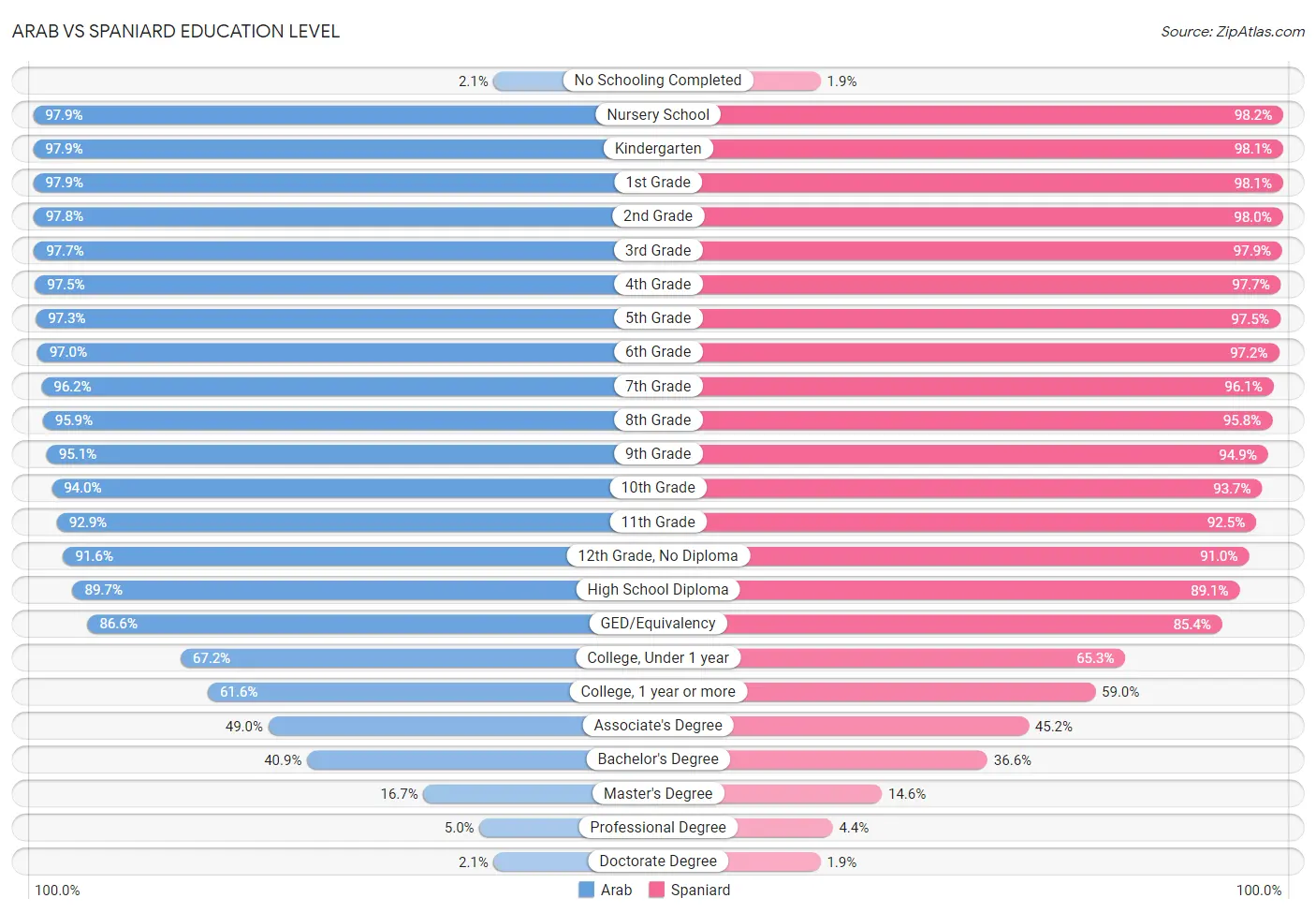
| Education Level Metric | Arab | Spaniard |
| No Schooling Completed | Average 2.1% | Exceptional 1.9% |
| Nursery School | Fair 97.9% | Exceptional 98.2% |
| Kindergarten | Fair 97.9% | Exceptional 98.1% |
| 1st Grade | Fair 97.9% | Exceptional 98.1% |
| 2nd Grade | Fair 97.8% | Exceptional 98.0% |
| 3rd Grade | Fair 97.7% | Excellent 97.9% |
| 4th Grade | Average 97.5% | Excellent 97.7% |
| 5th Grade | Average 97.3% | Excellent 97.5% |
| 6th Grade | Average 97.0% | Excellent 97.2% |
| 7th Grade | Good 96.2% | Good 96.1% |
| 8th Grade | Good 95.9% | Good 95.8% |
| 9th Grade | Good 95.1% | Average 94.9% |
| 10th Grade | Excellent 94.0% | Average 93.7% |
| 11th Grade | Excellent 92.9% | Average 92.5% |
| 12th Grade, No Diploma | Excellent 91.6% | Fair 91.0% |
| High School Diploma | Excellent 89.7% | Average 89.1% |
| GED/Equivalency | Excellent 86.6% | Fair 85.4% |
| College, Under 1 year | Exceptional 67.2% | Average 65.3% |
| College, 1 year or more | Exceptional 61.6% | Fair 59.0% |
| Associate's Degree | Exceptional 49.0% | Fair 45.2% |
| Bachelor's Degree | Exceptional 40.9% | Fair 36.6% |
| Master's Degree | Exceptional 16.7% | Fair 14.6% |
| Professional Degree | Exceptional 5.0% | Average 4.4% |
| Doctorate Degree | Exceptional 2.1% | Good 1.9% |
Arab vs Spaniard Disability
When considering disability, the most significant differences between Arab and Spaniard communities in the United States are seen in hearing disability (3.0% compared to 3.5%, a difference of 17.3%), vision disability (2.1% compared to 2.4%, a difference of 14.8%), and disability age 35 to 64 (10.9% compared to 12.3%, a difference of 12.3%). Conversely, both communities are more comparable in terms of cognitive disability (17.3% compared to 17.3%, a difference of 0.070%), disability age over 75 (47.1% compared to 48.1%, a difference of 2.1%), and self-care disability (2.4% compared to 2.6%, a difference of 5.3%).
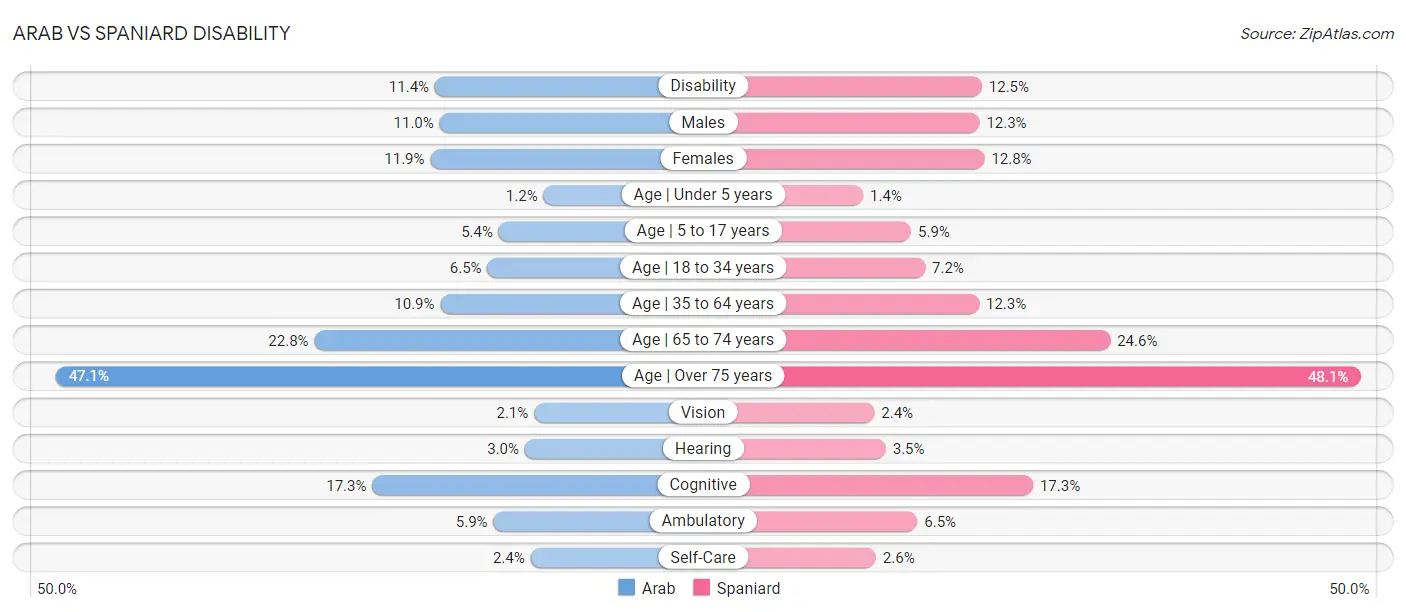
| Disability Metric | Arab | Spaniard |
| Disability | Excellent 11.4% | Tragic 12.5% |
| Males | Excellent 11.0% | Tragic 12.3% |
| Females | Exceptional 11.9% | Tragic 12.8% |
| Age | Under 5 years | Good 1.2% | Tragic 1.4% |
| Age | 5 to 17 years | Exceptional 5.4% | Tragic 5.9% |
| Age | 18 to 34 years | Good 6.5% | Tragic 7.2% |
| Age | 35 to 64 years | Excellent 10.9% | Tragic 12.3% |
| Age | 65 to 74 years | Excellent 22.8% | Tragic 24.6% |
| Age | Over 75 years | Good 47.1% | Tragic 48.1% |
| Vision | Excellent 2.1% | Tragic 2.4% |
| Hearing | Average 3.0% | Tragic 3.5% |
| Cognitive | Average 17.3% | Average 17.3% |
| Ambulatory | Exceptional 5.9% | Tragic 6.5% |
| Self-Care | Good 2.4% | Tragic 2.6% |